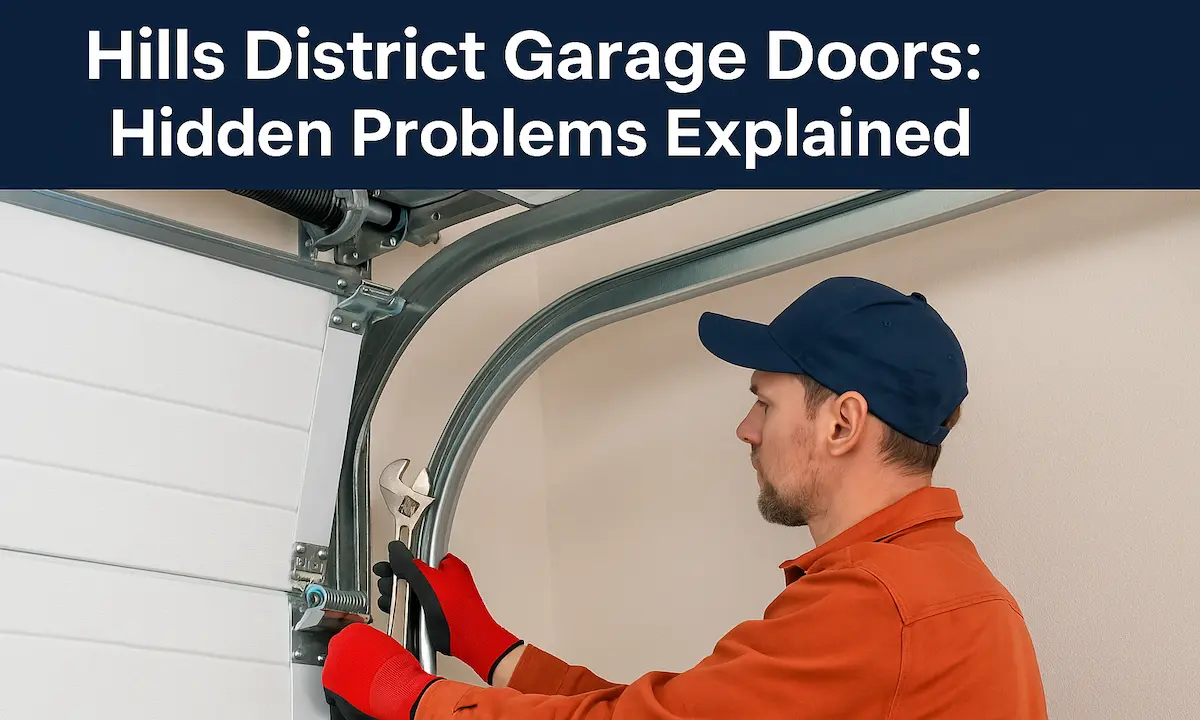In Sydney’s Hills District, garage doors often work harder than homeowners realize. They are expected to function flawlessly year-round, enduring scorching summers, damp winters, and the pressure of daily use.
Yet, most people don’t give their garage doors a second thought—until something goes wrong. One of the most underrated and damaging issues? Track misalignment.
This article dives deep into the hidden problems affecting garage doors in Castle Hill, Glenhaven, Kellyville, and Baulkham Hills. We’ll explore what causes these problems, how to spot the signs early, and what you can do to prevent them from escalating.
Why the Hills District Is Tough on Garage Doors
Garage doors in the Hills District operate under unique environmental stress. From steep driveways to constant weather shifts, they face wear and tear that most areas don’t experience. Understanding these challenges is the first step to preventing long-term damage.
These subtle environmental impacts often go unnoticed until they create major mechanical issues. Let’s break down the most common regional factors affecting garage door systems.
1. Sloped Driveways Increase Mechanical Stress
Many homes in the Hills District are built on hilly terrain. This architectural design may boost curb appeal, but it places added stress on the garage door’s mechanisms.
When a door must function on an incline, the rollers, tracks, and motor work harder than usual. Over time, this imbalance leads to misaligned tracks and premature wear.
2. Weather Extremes Are Constant
Sydney’s climate is notoriously unpredictable. One week can include both sweltering heat and heavy storms. These temperature shifts cause metal components to expand and contract, while wood doors absorb moisture and swell. Over time, this warping causes doors to stick or jam.
3. Persistent Humidity Breeds Rust
The Hills District experiences high humidity levels, especially during the warmer months. Moisture settles into hinges, brackets, and track grooves, silently rusting parts that are essential to the door’s function. Left unchecked, rust can seize moving parts and lead to dangerous malfunctions.
Read More: ShutterGo: Redefining Smart Homes with Visual Intelligence
Misaligned Tracks: The Silent Killer of Garage Doors
Misaligned tracks are one of the most overlooked yet damaging issues a garage door can face. They begin quietly and worsen with every use, increasing wear on vital components.
By the time homeowners notice, the problem has usually escalated into a costly repair. Identifying and correcting misalignment early can save time and money.
Subtle Signs That Lead to Major Repairs
Track misalignment develops gradually. Initially, you might notice a minor squeak or the door appearing slightly crooked. Since the door still operates, most homeowners dismiss these signs.
However, each use places increased strain on the opener and rollers. The longer misalignment is ignored, the more costly the repairs become. It can eventually damage the springs, cables, and even the structural integrity of the garage frame.
How Misalignment Affects the Whole System
- Rollers wear unevenly
- Cable tension becomes imbalanced
- Spring pressure shifts
- Motor pulls harder on one side
This domino effect means a simple $150 adjustment could snowball into an $800 repair.
Common Garage Door Problems and Their Symptoms
| Problem | Symptom | Severity |
|---|---|---|
| Track Misalignment | Wobbling door, uneven movement | High |
| Rusted Hinges or Brackets | Squeaking, resistance during motion | Medium |
| Loose Hardware | Rattling noises | Medium |
| Worn Rollers | Jerky motion, loud grinding | High |
| Spring Tension Imbalance | One side moves faster/slower | Critical |
Warning Sounds: What That Rattle Really Means
Noisy garage doors are more than just a nuisance. They’re often a warning sign of underlying problems that could soon lead to breakdowns or safety hazards.
Understanding these sounds and their causes can help you take preventative action before the situation worsens.
Loose Hardware
Vibration from daily use loosens bolts and screws. This starts with a small rattle and, if ignored, leads to larger mechanical failure.
Cracked Rollers
Over time, rollers become brittle and crack. Cheap rollers may even flatten, creating resistance within the track.
Spring Issues
When torsion springs lose balance, they make audible creaks and add pressure to one side of the door. If one spring carries more weight than the other, breakdown is imminent.
Costly DIY Fixes That Make Things Worse
While it’s tempting to take garage door repairs into your own hands, DIY fixes can often cause more harm than good. Misusing tools or applying incorrect products may lead to irreversible damage.
Homeowners must recognize when professional intervention is necessary, especially with heavy or high-tension systems.
WD-40 Isn’t the Miracle You Think It Is
Many homeowners reach for WD-40 to fix squeaks. However, it attracts dirt and can gum up tracks and rollers. Specialized garage door lubricants are better suited for the job.
Pulling the Door Manually
Attempting to “straighten” a crooked garage door often masks the underlying issue. You may damage the opener or bend the tracks further.
Adjusting Tension Without Tools
Cable tension is delicate. One incorrect adjustment can send the door slamming down or cause spring recoil, both of which are extremely dangerous.
DIY Fixes vs. Professional Solutions
| Issue | DIY Attempted Fix | Professional Solution |
| Squeaky Door | WD-40 Application | Proper lubrication + inspection |
| Crooked Door | Manual Force Adjustment | Track realignment + cable balance |
| Door Stuck Halfway | Push or Pull | Motor + sensor calibration |
| Grinding Sound | Ignore it | Replace rollers + inspect brackets |
The Engineering Behind Garage Doors: Why Precision Matters
Garage doors may appear simple, but they are highly engineered systems. Every component, from the cables to the opener, relies on balance and alignment.
Ignoring even the smallest issue can throw the whole mechanism off, leading to early wear or failure.
The Hidden Cost of Ignoring Minor Garage Issues
What seems like a small problem today can turn into a big, expensive repair tomorrow. Minor noises and performance issues are often early warnings of deeper mechanical faults.
The sooner these are addressed, the better the long-term outcome for your wallet and safety.
Also Visit: Best Textured Rugs for Living Room: Style Meets Comfort
The Role of Soil Movement in Garage Door Misalignment
Soil conditions play a big role in the long-term stability of your garage structure. Homes in areas with clay-rich soil often experience foundation shifts.
These shifts can subtly tilt garage floors, affecting track alignment and door performance.
Shifting Foundations
The clay-heavy soil in areas like North Rocks expands and contracts with rainfall. This causes garage slabs to shift subtly, which alters the position of your tracks and frame.
The Result: A Door That Never Stays Straight
You might keep adjusting your door, only to have it go crooked again. If the foundation isn’t level, realigning the door will never fully fix the problem until the root cause is addressed.
Long-Term Benefits of Preventative Maintenance
Investing in preventative care keeps your garage door running smoothly. It reduces wear on parts, extends the system’s lifespan, and improves overall safety.
Routine inspections and minor adjustments now can save you thousands later.
Expert Garage Door Checklist for Hills District Homeowners
Regular inspections help catch issues early. Following a seasonal checklist ensures your garage door is always functioning at its best.
Below is a simple maintenance plan every Hills District homeowner should follow.
- Inspect track brackets every 6 months
- Lubricate rollers and hinges twice a year
- Check balance by manually lifting halfway
- Listen for squeaks, rattles, or grinding
- Watch for uneven movement or lag
Selecting the Right Garage Door Repair Company
Choosing a qualified technician is just as important as recognizing the problem. The Hills District has unique terrain and weather patterns that not every company understands.
Look for local experience and a track record of trustworthy service.
What to Look For:
- Local experience with Hills District terrain
- Licensed technicians with insurance
- Transparent pricing and free quotes
- Positive online reviews and testimonials
Red Flags:
- High-pressure upselling
- Vague or shifting prices
- No warranty on labor or parts
FAQs
Q: Can I prevent track misalignment entirely?
A: You can significantly reduce the chances by keeping brackets tight, rollers lubricated, and the area around your garage dry and clear.
Q: Should I replace my garage door or just the tracks?
A: If the door is in good condition but the tracks are misaligned, a repair will suffice. Replacement is only needed for warped or damaged doors.
Q: Are timber garage doors more prone to issues?
A: Yes, wooden doors swell in humidity and may warp over time, especially without regular sealing.
Q: How long does a standard garage door last in the Hills District?
A: With proper care, 15 to 20 years. Without maintenance, expect major issues within 8 to 10 years.
Final Thoughts: Don’t Let Your Garage Door Fail You
Your garage door might seem sturdy, but in the Hills District’s challenging environment, it needs attention. Track misalignment is a slow-building problem that often goes unnoticed until it causes major damage. The good news? It’s preventable.
Schedule annual inspections, listen to your door, and invest in expert care. Whether you’re in Castle Hill, Baulkham Hills, Kellyville, or Glenhaven—stay one step ahead of garage door disasters.












